University Essay: International Migration and Economic Factors
VerifiedAdded on 2023/06/07
|10
|2795
|111
Essay
AI Summary
This essay examines the economic factors that are the key drivers of international migration. It explores the influence of multinational companies, employment opportunities, and wage differentials on global mobility. The essay highlights how factors such as job availability and wage rates in developed countries encourage migration from low- and middle-income countries. It also discusses the impact of migration on both host and origin countries, including the issue of brain drain and the importance of economic conditions. The essay further analyzes the role of global media and the concept of standard of living, including the impact of poverty, education, and currency rates in driving international migration. The essay also touches upon the neo-classical economic theories and new economics of migration and their implications on policy making. The essay also explores the impact of economic factors on migration, including employment, wage rates, and the standard of living, as well as the impact of poverty and education. The essay draws on the work of various scholars to support its arguments.

Running head: INTERNATIONAL MIGRATION AND MULTICULTURAL
International Migration and Multicultural
Name of the Student
Name of the University
Author’s note
International Migration and Multicultural
Name of the Student
Name of the University
Author’s note
Paraphrase This Document
Need a fresh take? Get an instant paraphrase of this document with our AI Paraphraser
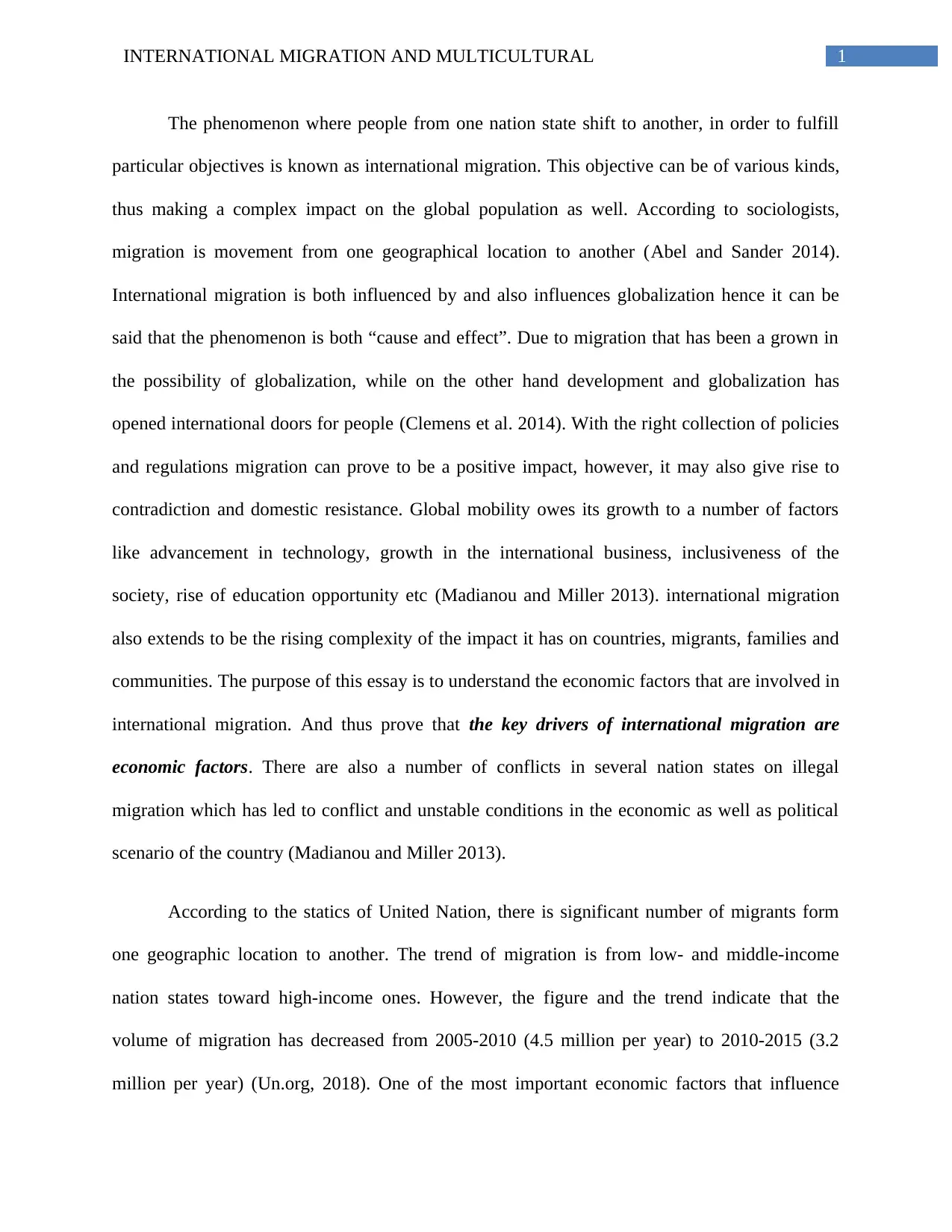
1INTERNATIONAL MIGRATION AND MULTICULTURAL
The phenomenon where people from one nation state shift to another, in order to fulfill
particular objectives is known as international migration. This objective can be of various kinds,
thus making a complex impact on the global population as well. According to sociologists,
migration is movement from one geographical location to another (Abel and Sander 2014).
International migration is both influenced by and also influences globalization hence it can be
said that the phenomenon is both “cause and effect”. Due to migration that has been a grown in
the possibility of globalization, while on the other hand development and globalization has
opened international doors for people (Clemens et al. 2014). With the right collection of policies
and regulations migration can prove to be a positive impact, however, it may also give rise to
contradiction and domestic resistance. Global mobility owes its growth to a number of factors
like advancement in technology, growth in the international business, inclusiveness of the
society, rise of education opportunity etc (Madianou and Miller 2013). international migration
also extends to be the rising complexity of the impact it has on countries, migrants, families and
communities. The purpose of this essay is to understand the economic factors that are involved in
international migration. And thus prove that the key drivers of international migration are
economic factors. There are also a number of conflicts in several nation states on illegal
migration which has led to conflict and unstable conditions in the economic as well as political
scenario of the country (Madianou and Miller 2013).
According to the statics of United Nation, there is significant number of migrants form
one geographic location to another. The trend of migration is from low- and middle-income
nation states toward high-income ones. However, the figure and the trend indicate that the
volume of migration has decreased from 2005-2010 (4.5 million per year) to 2010-2015 (3.2
million per year) (Un.org, 2018). One of the most important economic factors that influence
The phenomenon where people from one nation state shift to another, in order to fulfill
particular objectives is known as international migration. This objective can be of various kinds,
thus making a complex impact on the global population as well. According to sociologists,
migration is movement from one geographical location to another (Abel and Sander 2014).
International migration is both influenced by and also influences globalization hence it can be
said that the phenomenon is both “cause and effect”. Due to migration that has been a grown in
the possibility of globalization, while on the other hand development and globalization has
opened international doors for people (Clemens et al. 2014). With the right collection of policies
and regulations migration can prove to be a positive impact, however, it may also give rise to
contradiction and domestic resistance. Global mobility owes its growth to a number of factors
like advancement in technology, growth in the international business, inclusiveness of the
society, rise of education opportunity etc (Madianou and Miller 2013). international migration
also extends to be the rising complexity of the impact it has on countries, migrants, families and
communities. The purpose of this essay is to understand the economic factors that are involved in
international migration. And thus prove that the key drivers of international migration are
economic factors. There are also a number of conflicts in several nation states on illegal
migration which has led to conflict and unstable conditions in the economic as well as political
scenario of the country (Madianou and Miller 2013).
According to the statics of United Nation, there is significant number of migrants form
one geographic location to another. The trend of migration is from low- and middle-income
nation states toward high-income ones. However, the figure and the trend indicate that the
volume of migration has decreased from 2005-2010 (4.5 million per year) to 2010-2015 (3.2
million per year) (Un.org, 2018). One of the most important economic factors that influence
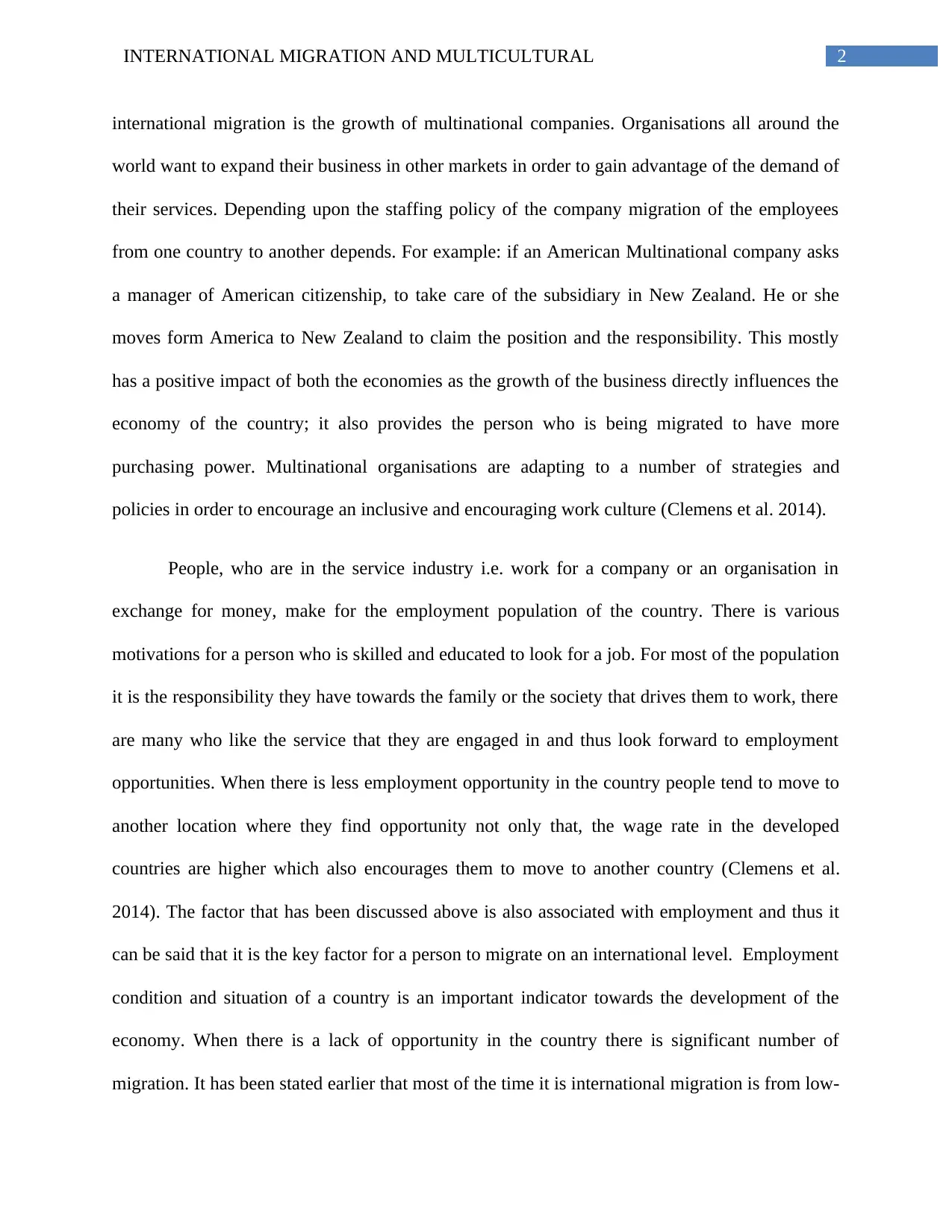
2INTERNATIONAL MIGRATION AND MULTICULTURAL
international migration is the growth of multinational companies. Organisations all around the
world want to expand their business in other markets in order to gain advantage of the demand of
their services. Depending upon the staffing policy of the company migration of the employees
from one country to another depends. For example: if an American Multinational company asks
a manager of American citizenship, to take care of the subsidiary in New Zealand. He or she
moves form America to New Zealand to claim the position and the responsibility. This mostly
has a positive impact of both the economies as the growth of the business directly influences the
economy of the country; it also provides the person who is being migrated to have more
purchasing power. Multinational organisations are adapting to a number of strategies and
policies in order to encourage an inclusive and encouraging work culture (Clemens et al. 2014).
People, who are in the service industry i.e. work for a company or an organisation in
exchange for money, make for the employment population of the country. There is various
motivations for a person who is skilled and educated to look for a job. For most of the population
it is the responsibility they have towards the family or the society that drives them to work, there
are many who like the service that they are engaged in and thus look forward to employment
opportunities. When there is less employment opportunity in the country people tend to move to
another location where they find opportunity not only that, the wage rate in the developed
countries are higher which also encourages them to move to another country (Clemens et al.
2014). The factor that has been discussed above is also associated with employment and thus it
can be said that it is the key factor for a person to migrate on an international level. Employment
condition and situation of a country is an important indicator towards the development of the
economy. When there is a lack of opportunity in the country there is significant number of
migration. It has been stated earlier that most of the time it is international migration is from low-
international migration is the growth of multinational companies. Organisations all around the
world want to expand their business in other markets in order to gain advantage of the demand of
their services. Depending upon the staffing policy of the company migration of the employees
from one country to another depends. For example: if an American Multinational company asks
a manager of American citizenship, to take care of the subsidiary in New Zealand. He or she
moves form America to New Zealand to claim the position and the responsibility. This mostly
has a positive impact of both the economies as the growth of the business directly influences the
economy of the country; it also provides the person who is being migrated to have more
purchasing power. Multinational organisations are adapting to a number of strategies and
policies in order to encourage an inclusive and encouraging work culture (Clemens et al. 2014).
People, who are in the service industry i.e. work for a company or an organisation in
exchange for money, make for the employment population of the country. There is various
motivations for a person who is skilled and educated to look for a job. For most of the population
it is the responsibility they have towards the family or the society that drives them to work, there
are many who like the service that they are engaged in and thus look forward to employment
opportunities. When there is less employment opportunity in the country people tend to move to
another location where they find opportunity not only that, the wage rate in the developed
countries are higher which also encourages them to move to another country (Clemens et al.
2014). The factor that has been discussed above is also associated with employment and thus it
can be said that it is the key factor for a person to migrate on an international level. Employment
condition and situation of a country is an important indicator towards the development of the
economy. When there is a lack of opportunity in the country there is significant number of
migration. It has been stated earlier that most of the time it is international migration is from low-
⊘ This is a preview!⊘
Do you want full access?
Subscribe today to unlock all pages.

Trusted by 1+ million students worldwide
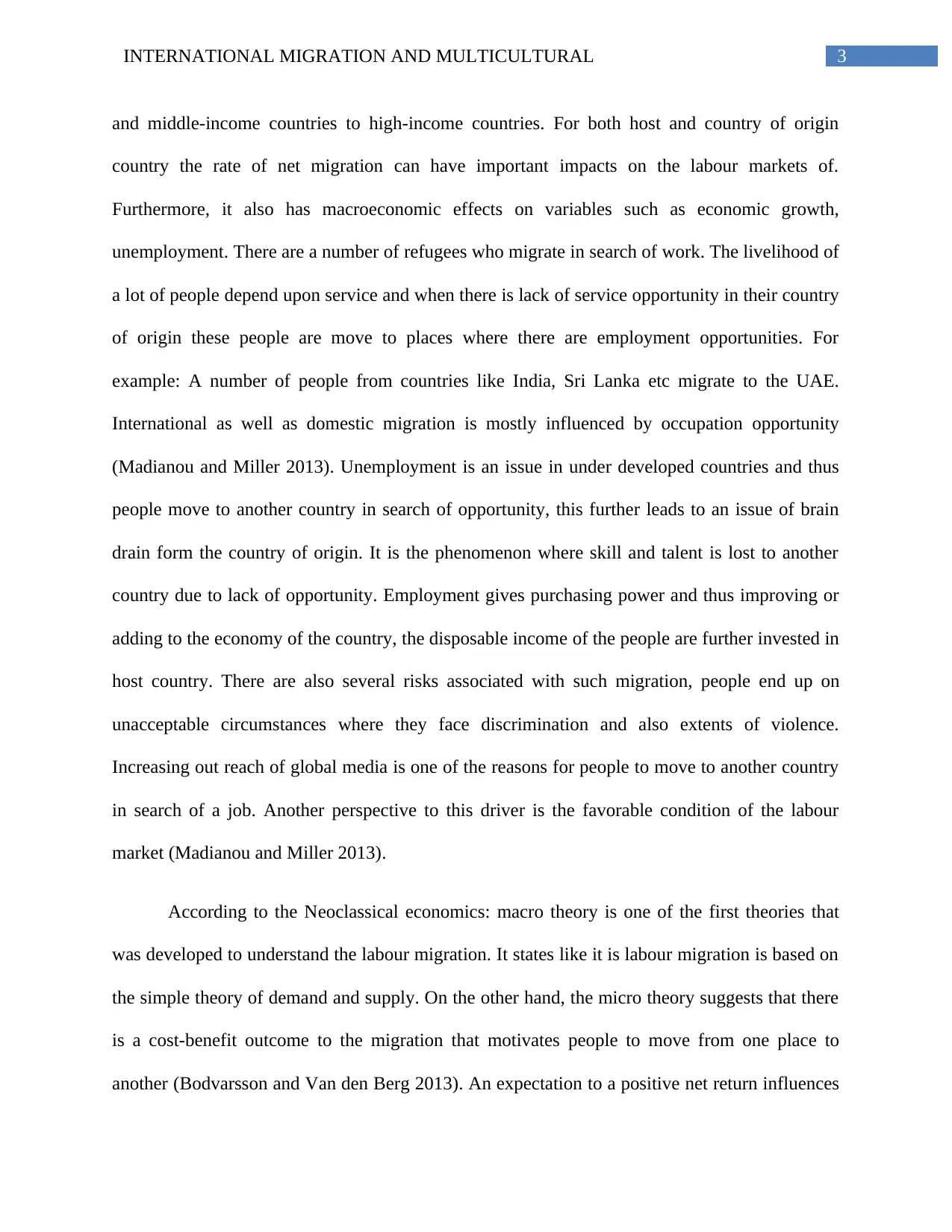
3INTERNATIONAL MIGRATION AND MULTICULTURAL
and middle-income countries to high-income countries. For both host and country of origin
country the rate of net migration can have important impacts on the labour markets of.
Furthermore, it also has macroeconomic effects on variables such as economic growth,
unemployment. There are a number of refugees who migrate in search of work. The livelihood of
a lot of people depend upon service and when there is lack of service opportunity in their country
of origin these people are move to places where there are employment opportunities. For
example: A number of people from countries like India, Sri Lanka etc migrate to the UAE.
International as well as domestic migration is mostly influenced by occupation opportunity
(Madianou and Miller 2013). Unemployment is an issue in under developed countries and thus
people move to another country in search of opportunity, this further leads to an issue of brain
drain form the country of origin. It is the phenomenon where skill and talent is lost to another
country due to lack of opportunity. Employment gives purchasing power and thus improving or
adding to the economy of the country, the disposable income of the people are further invested in
host country. There are also several risks associated with such migration, people end up on
unacceptable circumstances where they face discrimination and also extents of violence.
Increasing out reach of global media is one of the reasons for people to move to another country
in search of a job. Another perspective to this driver is the favorable condition of the labour
market (Madianou and Miller 2013).
According to the Neoclassical economics: macro theory is one of the first theories that
was developed to understand the labour migration. It states like it is labour migration is based on
the simple theory of demand and supply. On the other hand, the micro theory suggests that there
is a cost-benefit outcome to the migration that motivates people to move from one place to
another (Bodvarsson and Van den Berg 2013). An expectation to a positive net return influences
and middle-income countries to high-income countries. For both host and country of origin
country the rate of net migration can have important impacts on the labour markets of.
Furthermore, it also has macroeconomic effects on variables such as economic growth,
unemployment. There are a number of refugees who migrate in search of work. The livelihood of
a lot of people depend upon service and when there is lack of service opportunity in their country
of origin these people are move to places where there are employment opportunities. For
example: A number of people from countries like India, Sri Lanka etc migrate to the UAE.
International as well as domestic migration is mostly influenced by occupation opportunity
(Madianou and Miller 2013). Unemployment is an issue in under developed countries and thus
people move to another country in search of opportunity, this further leads to an issue of brain
drain form the country of origin. It is the phenomenon where skill and talent is lost to another
country due to lack of opportunity. Employment gives purchasing power and thus improving or
adding to the economy of the country, the disposable income of the people are further invested in
host country. There are also several risks associated with such migration, people end up on
unacceptable circumstances where they face discrimination and also extents of violence.
Increasing out reach of global media is one of the reasons for people to move to another country
in search of a job. Another perspective to this driver is the favorable condition of the labour
market (Madianou and Miller 2013).
According to the Neoclassical economics: macro theory is one of the first theories that
was developed to understand the labour migration. It states like it is labour migration is based on
the simple theory of demand and supply. On the other hand, the micro theory suggests that there
is a cost-benefit outcome to the migration that motivates people to move from one place to
another (Bodvarsson and Van den Berg 2013). An expectation to a positive net return influences
Paraphrase This Document
Need a fresh take? Get an instant paraphrase of this document with our AI Paraphraser

4INTERNATIONAL MIGRATION AND MULTICULTURAL
the migration. These assumptions of net returns are based on the observation of the income
associated with the corresponding skills. The choice of movement is based on their assumption
of productivity based on the skill and talent. However, there are a number of costs that are
associated with the movement before any benefit is yield. Some of the costs like travelling and
maintenance while looking for a job, learning a new language and culture of the new place etc.
The new economies of migration give a completely different insight to the phenomenon;
it states that migration does not occur on the basis of just one isolated objective. This is due to
maximize the income opportunities and minimize the risks associated with the migration process
(Arango 2017). All the theories regarding international immigration help the policy makers as
they are not always contradictory in nature by incorporating the elements for the these theories
by the policy makers chose to employee conditions like changing wages and employment
conditions in the countries of destination (Arango 2017).
The labour in the country is paid in sync with the economic condition that is prevalent in
the country. Global labour migration is dependent and is promoted by economic factors. For
example: the cost of labour is high in American states than in Pakistan. Therefore people from an
underdeveloped country will want to work in a developed one in order to not only have a better
chance of employment but also get rewarded in a better way (Clemens et al. 2014). The
difference in wage rate in between the host country and the country of origin is one of the main
reasons for international migration. There are a number of economic factors associated with this
difference in wage rate as for the service sector the remuneration is what makes for the
disposable income (Castles 2013).
the migration. These assumptions of net returns are based on the observation of the income
associated with the corresponding skills. The choice of movement is based on their assumption
of productivity based on the skill and talent. However, there are a number of costs that are
associated with the movement before any benefit is yield. Some of the costs like travelling and
maintenance while looking for a job, learning a new language and culture of the new place etc.
The new economies of migration give a completely different insight to the phenomenon;
it states that migration does not occur on the basis of just one isolated objective. This is due to
maximize the income opportunities and minimize the risks associated with the migration process
(Arango 2017). All the theories regarding international immigration help the policy makers as
they are not always contradictory in nature by incorporating the elements for the these theories
by the policy makers chose to employee conditions like changing wages and employment
conditions in the countries of destination (Arango 2017).
The labour in the country is paid in sync with the economic condition that is prevalent in
the country. Global labour migration is dependent and is promoted by economic factors. For
example: the cost of labour is high in American states than in Pakistan. Therefore people from an
underdeveloped country will want to work in a developed one in order to not only have a better
chance of employment but also get rewarded in a better way (Clemens et al. 2014). The
difference in wage rate in between the host country and the country of origin is one of the main
reasons for international migration. There are a number of economic factors associated with this
difference in wage rate as for the service sector the remuneration is what makes for the
disposable income (Castles 2013).
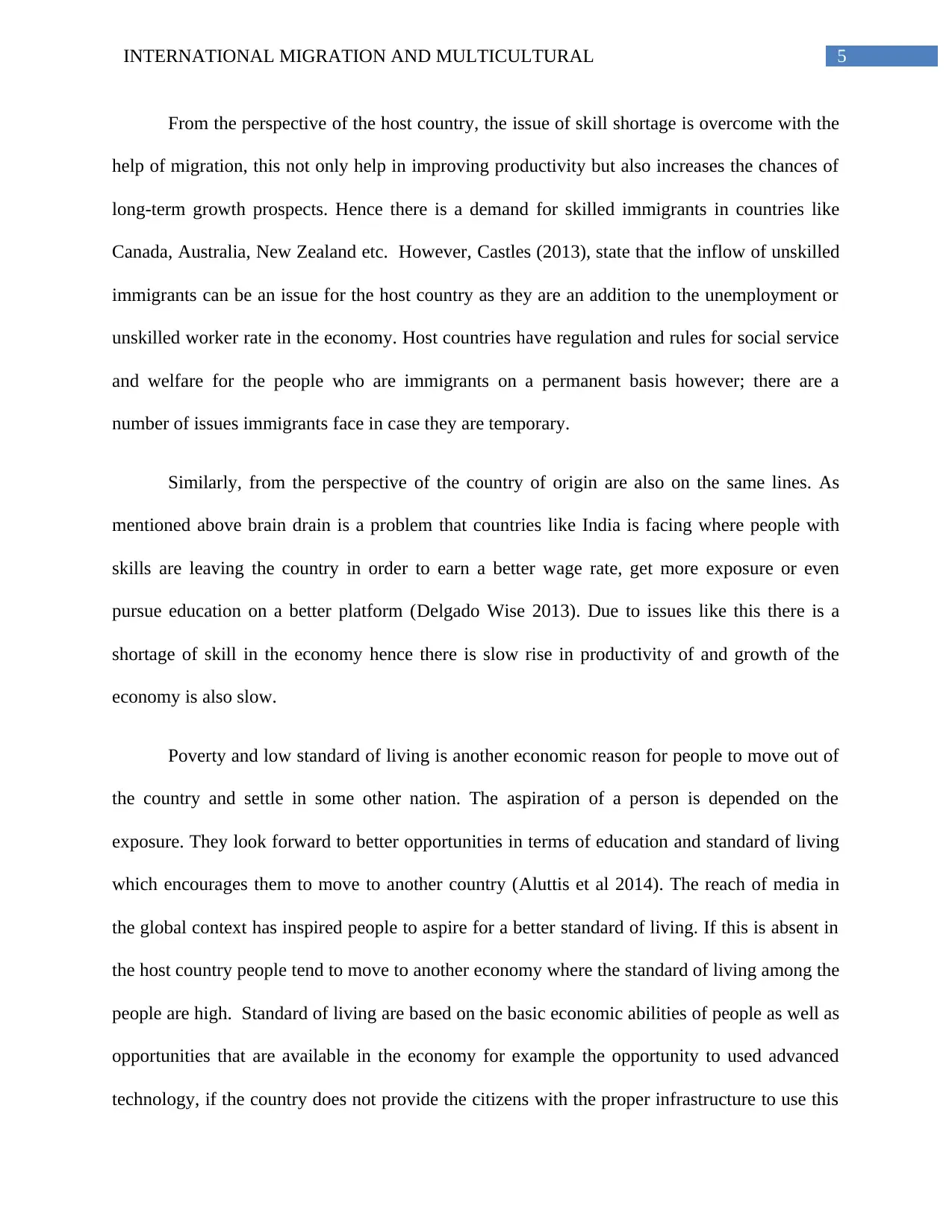
5INTERNATIONAL MIGRATION AND MULTICULTURAL
From the perspective of the host country, the issue of skill shortage is overcome with the
help of migration, this not only help in improving productivity but also increases the chances of
long-term growth prospects. Hence there is a demand for skilled immigrants in countries like
Canada, Australia, New Zealand etc. However, Castles (2013), state that the inflow of unskilled
immigrants can be an issue for the host country as they are an addition to the unemployment or
unskilled worker rate in the economy. Host countries have regulation and rules for social service
and welfare for the people who are immigrants on a permanent basis however; there are a
number of issues immigrants face in case they are temporary.
Similarly, from the perspective of the country of origin are also on the same lines. As
mentioned above brain drain is a problem that countries like India is facing where people with
skills are leaving the country in order to earn a better wage rate, get more exposure or even
pursue education on a better platform (Delgado Wise 2013). Due to issues like this there is a
shortage of skill in the economy hence there is slow rise in productivity of and growth of the
economy is also slow.
Poverty and low standard of living is another economic reason for people to move out of
the country and settle in some other nation. The aspiration of a person is depended on the
exposure. They look forward to better opportunities in terms of education and standard of living
which encourages them to move to another country (Aluttis et al 2014). The reach of media in
the global context has inspired people to aspire for a better standard of living. If this is absent in
the host country people tend to move to another economy where the standard of living among the
people are high. Standard of living are based on the basic economic abilities of people as well as
opportunities that are available in the economy for example the opportunity to used advanced
technology, if the country does not provide the citizens with the proper infrastructure to use this
From the perspective of the host country, the issue of skill shortage is overcome with the
help of migration, this not only help in improving productivity but also increases the chances of
long-term growth prospects. Hence there is a demand for skilled immigrants in countries like
Canada, Australia, New Zealand etc. However, Castles (2013), state that the inflow of unskilled
immigrants can be an issue for the host country as they are an addition to the unemployment or
unskilled worker rate in the economy. Host countries have regulation and rules for social service
and welfare for the people who are immigrants on a permanent basis however; there are a
number of issues immigrants face in case they are temporary.
Similarly, from the perspective of the country of origin are also on the same lines. As
mentioned above brain drain is a problem that countries like India is facing where people with
skills are leaving the country in order to earn a better wage rate, get more exposure or even
pursue education on a better platform (Delgado Wise 2013). Due to issues like this there is a
shortage of skill in the economy hence there is slow rise in productivity of and growth of the
economy is also slow.
Poverty and low standard of living is another economic reason for people to move out of
the country and settle in some other nation. The aspiration of a person is depended on the
exposure. They look forward to better opportunities in terms of education and standard of living
which encourages them to move to another country (Aluttis et al 2014). The reach of media in
the global context has inspired people to aspire for a better standard of living. If this is absent in
the host country people tend to move to another economy where the standard of living among the
people are high. Standard of living are based on the basic economic abilities of people as well as
opportunities that are available in the economy for example the opportunity to used advanced
technology, if the country does not provide the citizens with the proper infrastructure to use this
⊘ This is a preview!⊘
Do you want full access?
Subscribe today to unlock all pages.

Trusted by 1+ million students worldwide

6INTERNATIONAL MIGRATION AND MULTICULTURAL
technology then it is a major hindrance in the process of consumption (Delgado Wise 2013).
Education is a major reason for which people move from one country to another, though not
being a direct economic reason but it is a factor that is associated with standard of living. Poverty
is another reason for a person to choose to move out of the country, high rate of poverty is an
indicator to an underdeveloped country (Madianou and Miller 2013). The currency rate of
underdeveloped countries are lower, people would like to earn in US Dollar or Euro in order to
improve their personal savings and investments. A person is always looking forward to
development in terms of economic and financial standards as well as standard of living (Delgado
Wise 2013).
Alternatively there are also many cases where there is involuntary migration from one
country to another based on social or political circumstances, this play an important role in the
refugees and migration issues all over the world (Braun and Mahmoud 2014). Situations like
political instability, war, cultural influences, family reasons and environmental changes etc are
some of the important reasons for people to migrate. The neo classical theory that has been
discussed above showcase a strong indication towards economic factors however it is based on a
number of assumptions. Both Arango’s segmented labour market theory as well as the
demographic approach does not consider non-economic factors. On the other hand, Igonin
(2016), argues that there are evidences that suggest otherwise, for example: there is a significant
rise of migration in Europe after War. There are also instances that families are driven out of the
country during war situations. Hence it can be said that cultural or ethnic intolerance, ambiguous
border drawing, military involvement and political conflicts can be significant reasons for
international migration (Igonin 2016).
technology then it is a major hindrance in the process of consumption (Delgado Wise 2013).
Education is a major reason for which people move from one country to another, though not
being a direct economic reason but it is a factor that is associated with standard of living. Poverty
is another reason for a person to choose to move out of the country, high rate of poverty is an
indicator to an underdeveloped country (Madianou and Miller 2013). The currency rate of
underdeveloped countries are lower, people would like to earn in US Dollar or Euro in order to
improve their personal savings and investments. A person is always looking forward to
development in terms of economic and financial standards as well as standard of living (Delgado
Wise 2013).
Alternatively there are also many cases where there is involuntary migration from one
country to another based on social or political circumstances, this play an important role in the
refugees and migration issues all over the world (Braun and Mahmoud 2014). Situations like
political instability, war, cultural influences, family reasons and environmental changes etc are
some of the important reasons for people to migrate. The neo classical theory that has been
discussed above showcase a strong indication towards economic factors however it is based on a
number of assumptions. Both Arango’s segmented labour market theory as well as the
demographic approach does not consider non-economic factors. On the other hand, Igonin
(2016), argues that there are evidences that suggest otherwise, for example: there is a significant
rise of migration in Europe after War. There are also instances that families are driven out of the
country during war situations. Hence it can be said that cultural or ethnic intolerance, ambiguous
border drawing, military involvement and political conflicts can be significant reasons for
international migration (Igonin 2016).
Paraphrase This Document
Need a fresh take? Get an instant paraphrase of this document with our AI Paraphraser
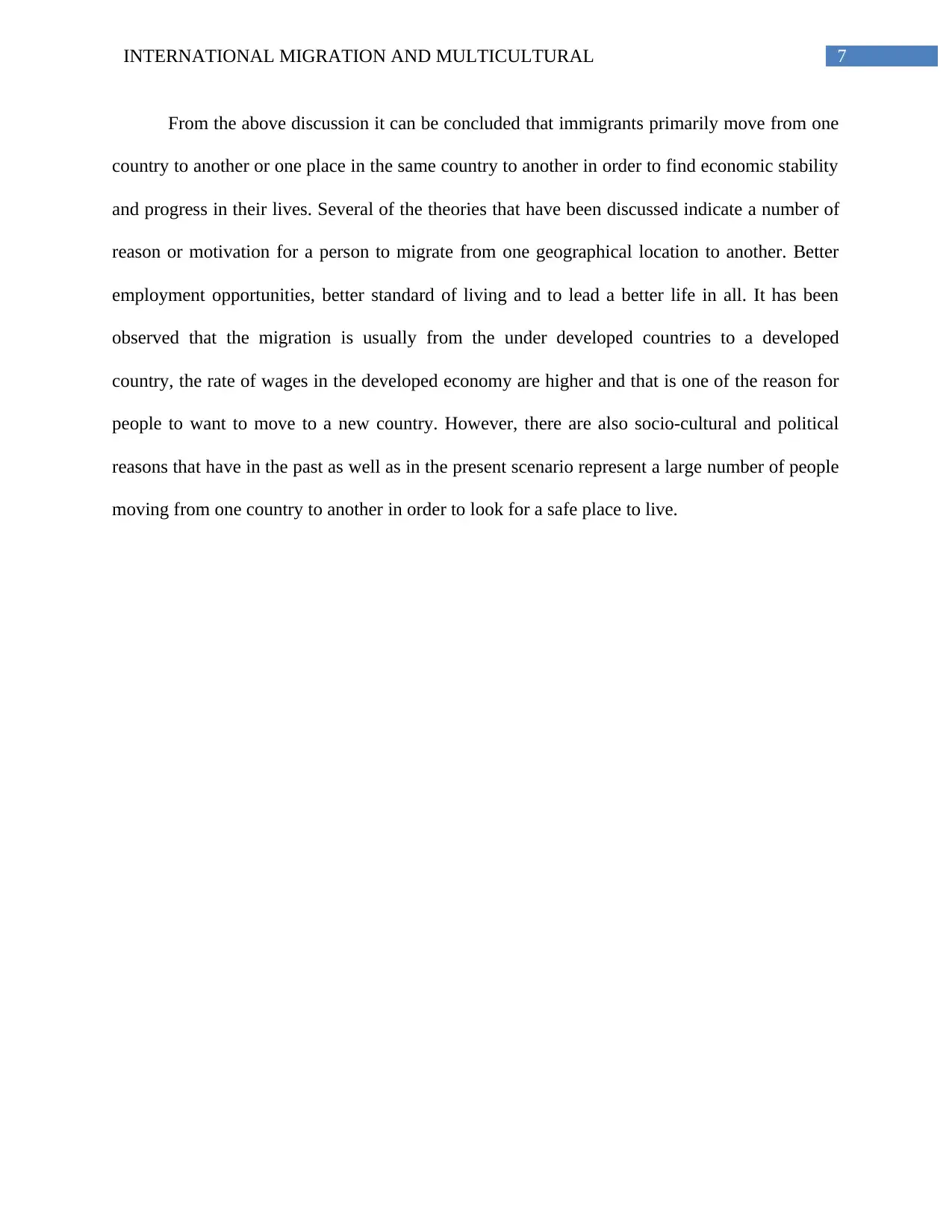
7INTERNATIONAL MIGRATION AND MULTICULTURAL
From the above discussion it can be concluded that immigrants primarily move from one
country to another or one place in the same country to another in order to find economic stability
and progress in their lives. Several of the theories that have been discussed indicate a number of
reason or motivation for a person to migrate from one geographical location to another. Better
employment opportunities, better standard of living and to lead a better life in all. It has been
observed that the migration is usually from the under developed countries to a developed
country, the rate of wages in the developed economy are higher and that is one of the reason for
people to want to move to a new country. However, there are also socio-cultural and political
reasons that have in the past as well as in the present scenario represent a large number of people
moving from one country to another in order to look for a safe place to live.
From the above discussion it can be concluded that immigrants primarily move from one
country to another or one place in the same country to another in order to find economic stability
and progress in their lives. Several of the theories that have been discussed indicate a number of
reason or motivation for a person to migrate from one geographical location to another. Better
employment opportunities, better standard of living and to lead a better life in all. It has been
observed that the migration is usually from the under developed countries to a developed
country, the rate of wages in the developed economy are higher and that is one of the reason for
people to want to move to a new country. However, there are also socio-cultural and political
reasons that have in the past as well as in the present scenario represent a large number of people
moving from one country to another in order to look for a safe place to live.
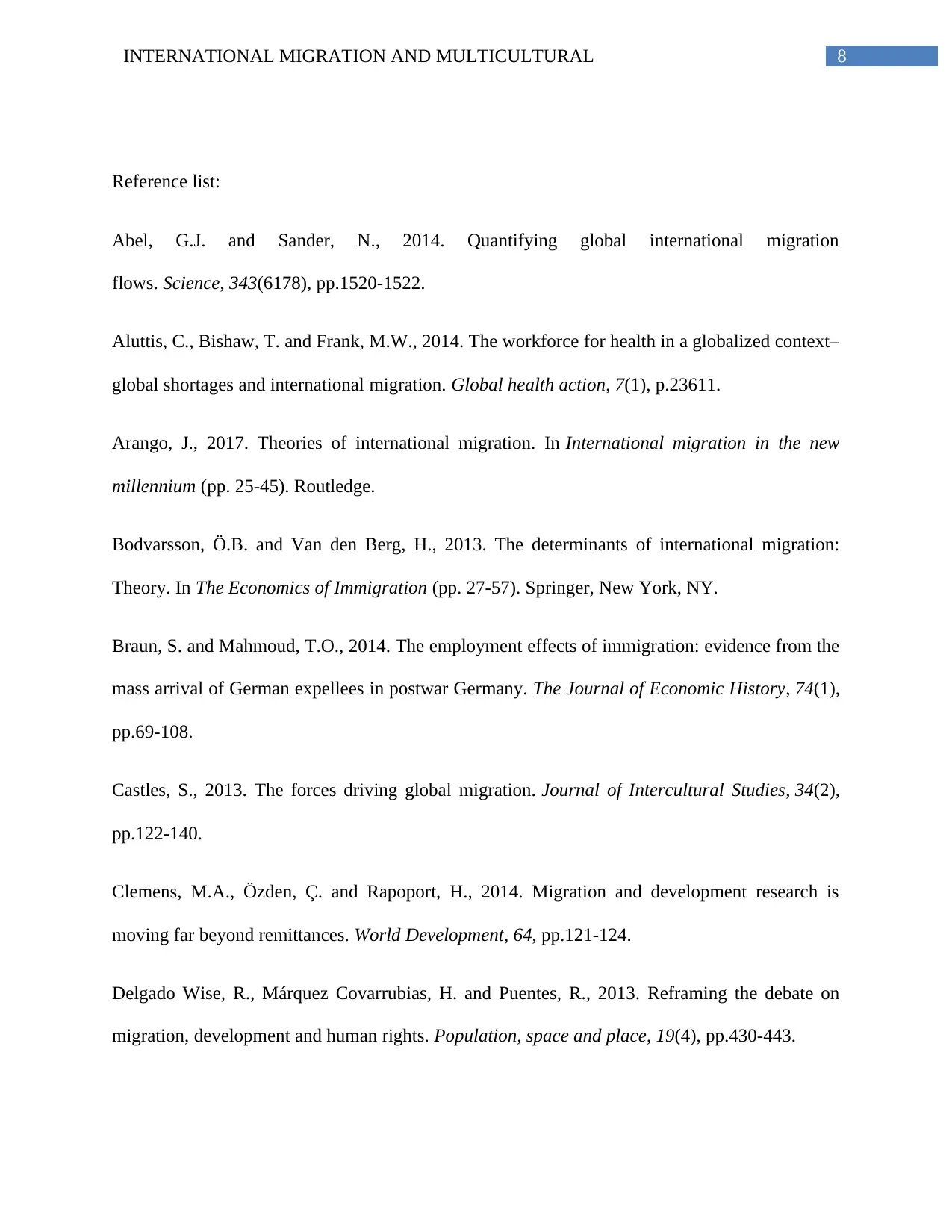
8INTERNATIONAL MIGRATION AND MULTICULTURAL
Reference list:
Abel, G.J. and Sander, N., 2014. Quantifying global international migration
flows. Science, 343(6178), pp.1520-1522.
Aluttis, C., Bishaw, T. and Frank, M.W., 2014. The workforce for health in a globalized context–
global shortages and international migration. Global health action, 7(1), p.23611.
Arango, J., 2017. Theories of international migration. In International migration in the new
millennium (pp. 25-45). Routledge.
Bodvarsson, Ö.B. and Van den Berg, H., 2013. The determinants of international migration:
Theory. In The Economics of Immigration (pp. 27-57). Springer, New York, NY.
Braun, S. and Mahmoud, T.O., 2014. The employment effects of immigration: evidence from the
mass arrival of German expellees in postwar Germany. The Journal of Economic History, 74(1),
pp.69-108.
Castles, S., 2013. The forces driving global migration. Journal of Intercultural Studies, 34(2),
pp.122-140.
Clemens, M.A., Özden, Ç. and Rapoport, H., 2014. Migration and development research is
moving far beyond remittances. World Development, 64, pp.121-124.
Delgado Wise, R., Márquez Covarrubias, H. and Puentes, R., 2013. Reframing the debate on
migration, development and human rights. Population, space and place, 19(4), pp.430-443.
Reference list:
Abel, G.J. and Sander, N., 2014. Quantifying global international migration
flows. Science, 343(6178), pp.1520-1522.
Aluttis, C., Bishaw, T. and Frank, M.W., 2014. The workforce for health in a globalized context–
global shortages and international migration. Global health action, 7(1), p.23611.
Arango, J., 2017. Theories of international migration. In International migration in the new
millennium (pp. 25-45). Routledge.
Bodvarsson, Ö.B. and Van den Berg, H., 2013. The determinants of international migration:
Theory. In The Economics of Immigration (pp. 27-57). Springer, New York, NY.
Braun, S. and Mahmoud, T.O., 2014. The employment effects of immigration: evidence from the
mass arrival of German expellees in postwar Germany. The Journal of Economic History, 74(1),
pp.69-108.
Castles, S., 2013. The forces driving global migration. Journal of Intercultural Studies, 34(2),
pp.122-140.
Clemens, M.A., Özden, Ç. and Rapoport, H., 2014. Migration and development research is
moving far beyond remittances. World Development, 64, pp.121-124.
Delgado Wise, R., Márquez Covarrubias, H. and Puentes, R., 2013. Reframing the debate on
migration, development and human rights. Population, space and place, 19(4), pp.430-443.
⊘ This is a preview!⊘
Do you want full access?
Subscribe today to unlock all pages.

Trusted by 1+ million students worldwide
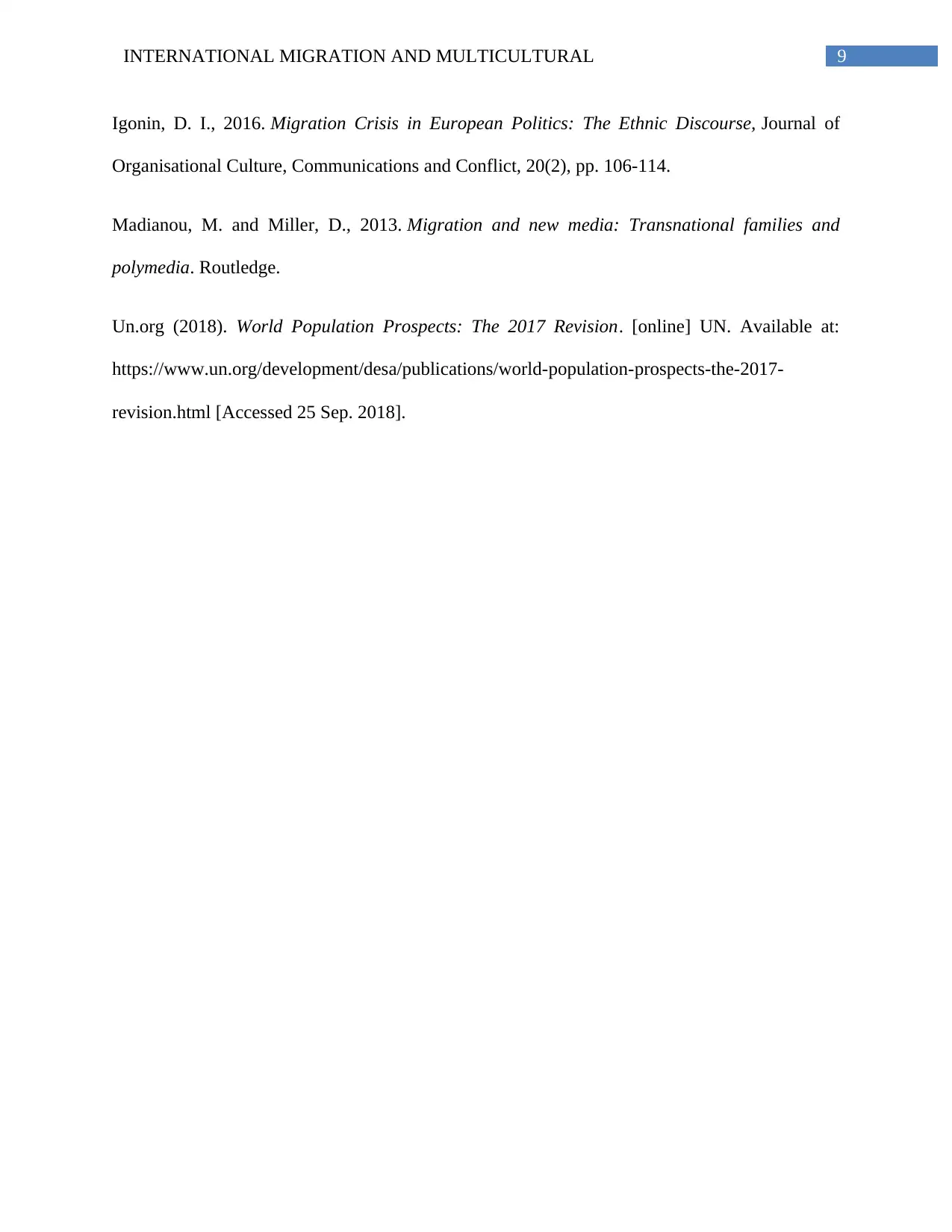
9INTERNATIONAL MIGRATION AND MULTICULTURAL
Igonin, D. I., 2016. Migration Crisis in European Politics: The Ethnic Discourse, Journal of
Organisational Culture, Communications and Conflict, 20(2), pp. 106-114.
Madianou, M. and Miller, D., 2013. Migration and new media: Transnational families and
polymedia. Routledge.
Un.org (2018). World Population Prospects: The 2017 Revision. [online] UN. Available at:
https://www.un.org/development/desa/publications/world-population-prospects-the-2017-
revision.html [Accessed 25 Sep. 2018].
Igonin, D. I., 2016. Migration Crisis in European Politics: The Ethnic Discourse, Journal of
Organisational Culture, Communications and Conflict, 20(2), pp. 106-114.
Madianou, M. and Miller, D., 2013. Migration and new media: Transnational families and
polymedia. Routledge.
Un.org (2018). World Population Prospects: The 2017 Revision. [online] UN. Available at:
https://www.un.org/development/desa/publications/world-population-prospects-the-2017-
revision.html [Accessed 25 Sep. 2018].
1 out of 10
Related Documents
Your All-in-One AI-Powered Toolkit for Academic Success.
+13062052269
info@desklib.com
Available 24*7 on WhatsApp / Email
![[object Object]](/_next/static/media/star-bottom.7253800d.svg)
Unlock your academic potential
Copyright © 2020–2025 A2Z Services. All Rights Reserved. Developed and managed by ZUCOL.





